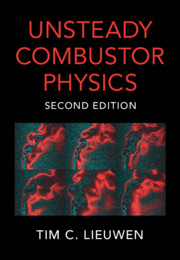Refine search
Actions for selected content:
8126 results in Fluid dynamics and solid mechanics
A MESHLESS LOCAL GALERKIN INTEGRAL EQUATION METHOD FOR SOLVING A TYPE OF DARBOUX PROBLEMS BASED ON RADIAL BASIS FUNCTIONS
- Part of
-
- Journal:
- The ANZIAM Journal / Volume 63 / Issue 4 / October 2021
- Published online by Cambridge University Press:
- 09 November 2021, pp. 469-492
-
- Article
- Export citation
BOUNDS ON THE CRITICAL TIMES FOR THE GENERAL FISHER–KPP EQUATION
- Part of
-
- Journal:
- The ANZIAM Journal / Volume 63 / Issue 4 / October 2021
- Published online by Cambridge University Press:
- 02 November 2021, pp. 448-468
-
- Article
- Export citation

Unsteady Combustor Physics
-
- Published online:
- 27 October 2021
- Print publication:
- 21 October 2021
IDEAL PLANAR FLUID FLOW OVER A SUBMERGED OBSTACLE: REVIEW AND EXTENSION
- Part of
-
- Journal:
- The ANZIAM Journal / Volume 63 / Issue 4 / October 2021
- Published online by Cambridge University Press:
- 25 October 2021, pp. 377-419
-
- Article
- Export citation
3 - Hydrodynamic Flow Stability I: Linear Instability
-
- Book:
- Unsteady Combustor Physics
- Published online:
- 27 October 2021
- Print publication:
- 21 October 2021, pp 81-112
-
- Chapter
- Export citation
Acknowledgments
-
- Book:
- Unsteady Combustor Physics
- Published online:
- 27 October 2021
- Print publication:
- 21 October 2021, pp xiv-xvi
-
- Chapter
- Export citation
Introduction
-
- Book:
- Unsteady Combustor Physics
- Published online:
- 27 October 2021
- Print publication:
- 21 October 2021, pp 1-6
-
- Chapter
- Export citation
1 - Basic Equations
-
- Book:
- Unsteady Combustor Physics
- Published online:
- 27 October 2021
- Print publication:
- 21 October 2021, pp 9-26
-
- Chapter
- Export citation
12 - Forced Response II: Heat Release Dynamics
-
- Book:
- Unsteady Combustor Physics
- Published online:
- 27 October 2021
- Print publication:
- 21 October 2021, pp 463-510
-
- Chapter
- Export citation
8 - Ignition
-
- Book:
- Unsteady Combustor Physics
- Published online:
- 27 October 2021
- Print publication:
- 21 October 2021, pp 296-320
-
- Chapter
- Export citation
Overview of the Book
-
- Book:
- Unsteady Combustor Physics
- Published online:
- 27 October 2021
- Print publication:
- 21 October 2021, pp 7-8
-
- Chapter
- Export citation
9 - Internal Flame Processes
-
- Book:
- Unsteady Combustor Physics
- Published online:
- 27 October 2021
- Print publication:
- 21 October 2021, pp 321-378
-
- Chapter
- Export citation
Summary Contents
-
- Book:
- Unsteady Combustor Physics
- Published online:
- 27 October 2021
- Print publication:
- 21 October 2021, pp v-vi
-
- Chapter
- Export citation
Detailed Contents
-
- Book:
- Unsteady Combustor Physics
- Published online:
- 27 October 2021
- Print publication:
- 21 October 2021, pp vii-xiii
-
- Chapter
- Export citation
Index
-
- Book:
- Unsteady Combustor Physics
- Published online:
- 27 October 2021
- Print publication:
- 21 October 2021, pp 511-516
-
- Chapter
- Export citation
4 - Hydrodynamic Flow Stability II: Common Combustor Flow Fields
-
- Book:
- Unsteady Combustor Physics
- Published online:
- 27 October 2021
- Print publication:
- 21 October 2021, pp 113-175
-
- Chapter
- Export citation
11 - Forced Response I: Flamelet Dynamics
-
- Book:
- Unsteady Combustor Physics
- Published online:
- 27 October 2021
- Print publication:
- 21 October 2021, pp 406-462
-
- Chapter
- Export citation
7 - Flame Sheet and Flow Interactions
-
- Book:
- Unsteady Combustor Physics
- Published online:
- 27 October 2021
- Print publication:
- 21 October 2021, pp 261-295
-
- Chapter
- Export citation
10 - Flame Stabilization, Flashback, Flameholding, and Blowoff
-
- Book:
- Unsteady Combustor Physics
- Published online:
- 27 October 2021
- Print publication:
- 21 October 2021, pp 379-405
-
- Chapter
- Export citation
Copyright page
-
- Book:
- Unsteady Combustor Physics
- Published online:
- 27 October 2021
- Print publication:
- 21 October 2021, pp iv-iv
-
- Chapter
- Export citation
